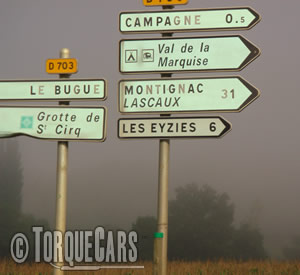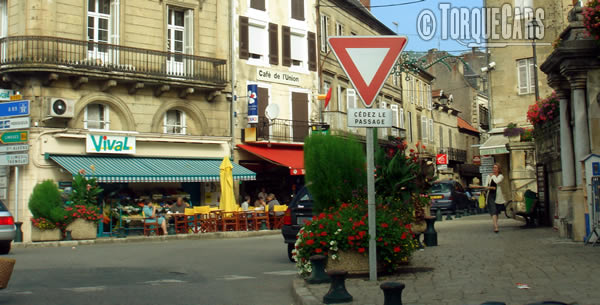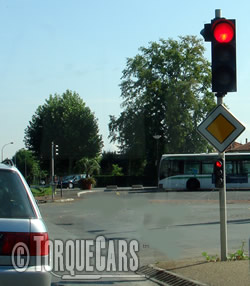Guide: Driving in France.
"Driving tips for France"
 If you are used to driving on UK roads you'll find it quite easy to drive over in France.
If you are used to driving on UK roads you'll find it quite easy to drive over in France.
Unlike in the UK, French roads are very well maintained and empty so there is little congestion or road works to contend with.
Many of our members prefer driving on French motorways finding it less stressful than in the UK.
It can take a while to get used to driving a left hand drive car though.
Compulsory paperwork and equipment you'll need for driving in France.
Carry the right documents with you so you can relax when stopped by the Police. You'll need to carry your cars registration documents, your insurance documents (they will need to be valid for driving in France) and of course a valid EU driving license.
You need to carry an authorisation letter from the owner if the vehicle isn't registered in your name. You must be over 18 and have a full driving license. Your car should be fitted with beam benders and a GB sticker and comply with French construction and use regulations.
In France you need to carry a spare set of bulbs, a warning triangle and a florescent jacket (for every person in the vehicle) to wear if the car breaks down. (In France you are required to wear a fluorescent jacket whenever you get out of the car on the main roads. A lot of people get caught out when stopped by the police forgetting to put the florescent jacket on.)
A first aid kit and fire extinguisher are recommended (these are compulsory in some EU countries). A recently added requirement stipulates that drivers carry a breath alcohol testing kit.
Driving in France.
Speed Limits
N.B. Built up area speed limits apply from the town name sign and finish with the sign that has the town name crossed through.

The reduced limits for wet roads will also apply to inexperienced drivers and visiting drivers who have held a license for less than 2 years.
|
|
Dry Roads |
Wet Roads |
||
|
Built up areas |
50kph |
31mph |
50kph |
31mph |
|
Single Carriageways |
90kph |
55mph |
80kph |
49mph |
|
Dual Carriageways & Non-Toll Motorways |
110kph |
68mph |
100kph |
62mph |
|
Toll Motorways |
130kph |
80mph |
110kph |
68mph |
Motoring Offenses
Expect to recieve an on the spot fine for speeding, and note that the UK and French authorities are working together to target reckless UK drivers, so use our printout to remind you of the limits and don't set a bad example!
The French police rigourously enforce stop lines, you must come to a complete stop if only for a moment. Also, when you are overtaking do not cross a solid white centre line or overtake near a slip road. The legally permitted blood alcohol level is also lower than in the UK.
Main Differences in France compared with the UK - you do not always have the right of way approaching roundabounts and at junctions.
A yellow diamond with a white border means you have priority. Passage protégé also means you have right of way.

A yellow diamond with a white border and black line through it means your priority ends and you must give way to traffic to your right. For example, if you are on a main road and you pass the crossed out yellow diamond sign you must give way to traffic coming from side roads to the right unless the side road has a stop line.
This also applies on many roundabouts, mainly in towns. Unless the signs or road markings show otherwise you have to stop on the roundabout to allow traffic from the right to join the roundabout.
At traffic lights, the flashing orange light or arrow means proceed with caution. Red means stop and green means go. Lights change a lot more quickly in France than they do in the UK so you have be pretty sharp.

Printout this page for easy reference when diriving, it helps to keep the table below near your dashboard for quick reference.
Handy phrases you will encounter on French road signs.
Parking Payant - Paid parking
Parking Gratuit - free parking
Feu Rouge - Red Light
Feu Vert - Green Light
A gauche - left
A droite - right
Tout Droit - Straight ahead
Piétons - pedestrians
Ralentissez - Lower your speed
Chaussée déformée - uneven road surface
Essence (sans plomb) - Petrol without lead (unleaded)
|
|
Dry Roads |
Wet Roads |
|
Built up areas |
31mph |
31mph |
|
Single Carriageways |
55mph |
49mph |
|
Dual Carriageways & Non-Toll Motorways |
68mph |
62mph |
|
Toll Motorways |
80mph |
68mph |
Dial 112 for Emergency services (local emergency services) but you can also dial directly to the following.
Police and Ambulance 17
Ambulance (SAMU) for emergency medical assistance 15
Fire 18
Enjoy your time in France, stay safe and enjoy the wonderfully smooth and straight French roads.
Please Check out my YouTube channel, we're regularly adding new content...
PLEASE HELP: I NEED YOUR DONATIONS TO COVER THE COSTS OF RUNNING THIS SITE AND KEEP IT RUNNING. I do not charge you to access this website and it saves most TorqueCars readers $100's each year - but we are NON PROFIT and not even covering our costs. To keep us running PLEASE Donate here
If you liked this page please share it with your friends, drop a link to it in your favourite forum or use the bookmarking options to save it to your social media profile.
Feedback - What do You Think?
Please use our forums if you wish to ask a tuning question, and please note we do not sell parts or services, we are just an online magazine.
Help us improve, leave a suggestion or tip
Please watch this video and subscribe to my YouTube channel.

 Click to accept YouTube Cookies & Play.
Click to accept YouTube Cookies & Play.